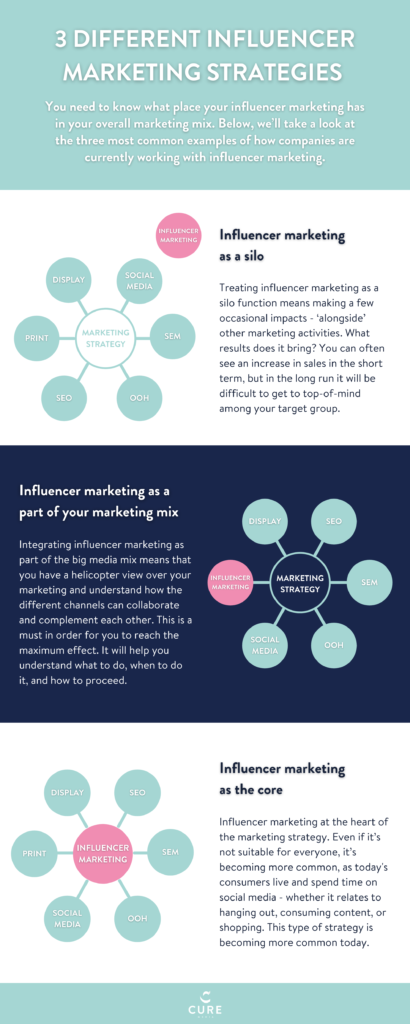There are three different influencer marketing approaches that can help you understand how you (consciously or unconsciously) have placed the channel in your media mix. Because how you work with influencer marketing, and if you choose to integrate it with the rest of your media mix, plays a big part in your success with the channel in the long run. It’s important to understand that this differs significantly from company to company. Below, we’ll take a look at the three most common examples of how companies are currently working with influencer marketing.
1. Influencer marketing as a silo
Treating influencer marketing as a silo function means making a few occasional impacts – ‘alongside’ other marketing activities. What results does it bring? You can often see an increase in sales in the short term, but in the long run it will be difficult to get to top-of-mind among your target group. The fact that the effect is short-term means influencer marketing as a silo function is not recommended. Influencer marketing has a lot of positive spill-over effects on other channels (which we’ll go further into later), which means you lose a lot of the biggest benefits of the channel if you don’t give it a meaningful enough place in your marketing mix.
2. Influencer marketing as a part of your marketing mix
More and more companies understand the importance of integrating influencer marketing as a part of the media mix – but there are just as many companies still working with silos. Integrating influencer marketing as part of the big media mix means that you have a helicopter view over your marketing and understand how the different channels can collaborate and complement each other. This is a must in order for you to reach the maximum effect. In addition, your strategy should be related to the rest of your marketing strategy for the year. It will help you understand what to do, when to do it, and how to proceed – to work methodically all the way, in simple terms.
Further reading: How does influencer marketing fit into the media mix.
3. Influencer marketing as the core
Today, there are a number of companies where influencer marketing is at the heart of their marketing strategy. Even if it’s not suitable for everyone, it’s becoming more common, as today’s consumers live and spend time on social media – whether it relates to hanging out, consuming content, or shopping. As an influencer agency UK, we’ve seen this type of strategy becoming more common today and there are several examples of successful brands using it, such as Gymshark and Daniel Wellington. These companies are often described as ‘influencer-born brands’.
Which strategy you choose to go with depends on various factors, such as who’s in your target audience and what product or service you’re selling. However, to succeed with influencer marketing in the long term, you should always avoid to treat it as a silo activity.
We hope that you’ve found this article helpful for your future, or current, influencer marketing strategy. Below you will find an infographic that summarises the three strategies.




